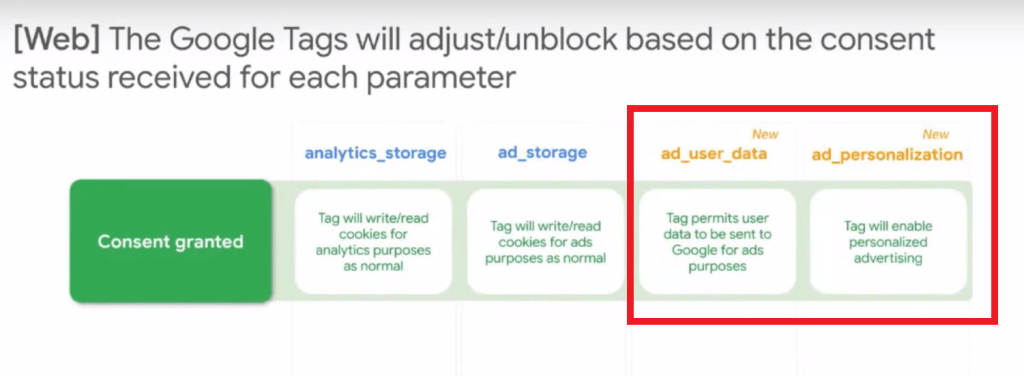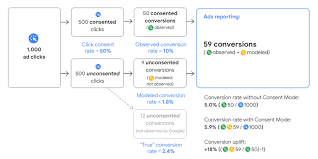What is Google Consent Mode, or Consent Mode v2, and how does it work? What are the causes? What about the consequences? What are the wished effects? How to deal with it?
What is Google Consent Mode, or Consent Mode v2, and how does it work?
The consent mode allows the user to accept the cookies that the website can track, and the kind of cookies. Specifically, basic cookies, technical cookies, marketing cookies or all cookies.
If the user refuses all of them, its behavior cannot be tracked, as the tag is blocked and does not report any data to Google Analytics.
Specifically, Google’s EU User Consent Policy (EUUCP) ensures compliance with EU regulations such as the GDPR, the ePrivacy Directive, and the DMA. These require user consent for tracking cookies and other similar technologies, such as personalized ads or data collection.
Certified CMP platforms, one of the best known is iubenda, for example, comply with compliance requirements and integrate all such advanced Google features, effectively offering support for Consent mode v2.
What are the causes?
Let’s try to understand what consent mode is in a slightly more technical way:
everything started from the need to protect users willing of not accepting all cookies, consequently avoiding remarketing and tracking their behavior on the site up to the moment of purchase/lead.
If the user enters the website and refuses all cookies, there is no way to get metrics on Google Analytics. If the user accepts only part of the cookies, we will be able to see their behavior on the site, without however having all their datas (for example age, gender and geographical location).
The problem does not pop up if the user accepts all cookies, then we will have complete tracking, that is very useful for our digital strategy.
Here you can find the link to an article that deeply explains how the current consent mode is technically constructed, on one of the most used programs, namely Iubenda.
What about the consequences?
With the new European legislation, Consent Mode v2 adds 2 new parameters to the list of those already present, which allow for more precise and legally compliant profiling: ad_user_data and ad_personalization.
If the user does not accept consent, and the tracking on the cookie bar is not updated with these parameters, very evident discrepancies in statistics may occur.
This is because these two parameters allow us to model the hypothetical behavior of users who do not accept cookies, in order to estimate a total of conversions that is as likely as possible.
Below we can see the behavior of the current consent mode, compared with the new consent mode v2, in a sufficiently intuitive way. image by Cookie-script.com an example photo from an expert in the sector.

What are the whished effects?
What do these 2 new parameters actually do? In order to comply with the European legislation that will come into force at the end of March, mandatory everywhere in Europe, namely the ePrivacy directive and the DMA, two new parameters have been introduced.
Their main goal is the further profiling of the customer and his behavior on the website. These gave rise to the technicality of consent mode v2.
The target is the following: willing to better protect the user and its browsing, if the user does not accept cookies, or at least partially, he does not give consent to their storage and analysis, therefore it cannot be part of the statistics of a website.
This leads to seeing fewer users than those who actually browse, leading to a strategy mismatch. In fact, assuming that out of 10 users, 7 give consent, 3 do not, we will no longer see the statistics of those 3 users, which means a data analysis discrepancy of 30%, which is a significant figure, especially on online advertising.
The image below, taken from the official Google Ads support guide, explains in a simple and exhaustive way what is best to avoid, therefore why install consent mode v2.
It is therefore understandable that implementing this new consent mode, the so-called consent mode v2, improves the effectiveness of behavioral and conversion models for users who have refused consent.

How to deal with it?
Let’s start from the point of having to check your consent mode: it is important, in the meantime, to verify that, via Google Tag Manager, or via code, the following parameters are present:
gtag('consent', 'default', {
'ad_storage': 'denied',
'ad_user_data': 'denied',
'ad_personalization': 'denied',
'analytics_storage': 'denied'
});
This means that the user refuses any type of cookie consent.
When users specify consent or change their choice, update the consent status using the update command. Because consent mode does not save consent choices, it updates the consent status as soon as a user interacts with your consent management solution.
The following code example shows how to update the consent state to granted when the user agrees to allow advertising cookies:
<script>
function consentGrantedAdStorage() {
gtag('consent', 'update', {
'ad_storage': 'granted'
});
}
</script>
<!-- Invoke your consent function when a user interacts with your banner -->
<body>
...
<button onclick="consentGrantedAdStorage()">Yes</button>
...
</body>
Therefore, as the Google guide for developers explains well, it is important to work on each parameter and its reference event, in order to have all the tracking of the variables (mostly customized) under control, and autonomous, as the The choice of cookies to accept is progressive (from none to all, passing through intermediate steps).
Users using the new consent mode, i.e. consent mode v2, must send two new parameters in addition to ad_storage and analytics_storage, which are as follows, included in a table for simplicity:
| Nome campo | Valori consentiti | Descrizione |
|---|---|---|
ad_ | 'granted' | | Set your consent for advertising-related user data to be sent to Google. |
ad_ | 'granted' | | Set consent for personalized advertising. |
This is why it is absolutely important to organize yourself in time, to adapt the current tracking to the new consent mode v2, in order to preserve your digital strategy in digital marketing on Google Ads
Still having problems tracking consent mode v2? Do you need an audit or a new implementation? Contact us using the form in the footer, we are at your disposal.

